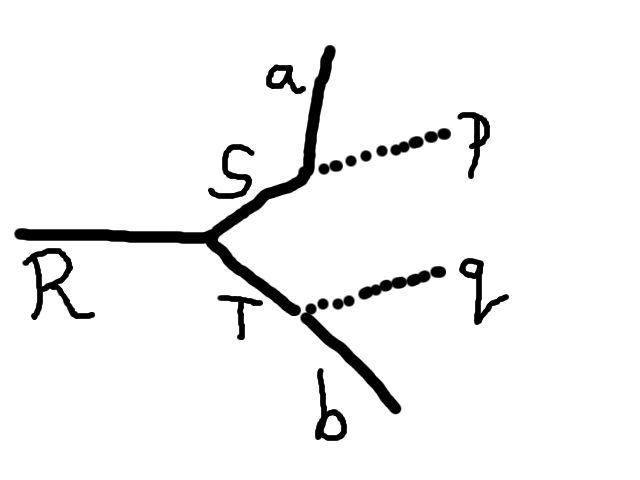These comments apply to the variabls mTBound, mTStar and mTTrue. This page exists to support the web-page documenting the C++ code that can be used to calculate them.

Consider the decay depicted above, in which a resonance "R" decays via two intermediate particles "S" and "T" in to four final state particles (or collections of particles) "a", "p", "q" and "b". In this decay, it is assumed that the particles (or particles) represented by "a" and the particle (or particles) represented by "b" are visible in the detector, whereas those represented by "p" and "q" are invisible, eg neutrinos. Assume that we cannot observe p and q, but we can observe "ptmiss", and let us consider only the case in which ptmiss is equal to the vector sum of the transverse components of p and q ... i.e. there are no other invisible particles in the event.
To calculate the greatest possible lower bound on the mass of the resonance R assuming that "a", "b", "p" and "q" are the only decay products of the resonance, and that both "S" and "T" are on mass shell at a specified mass, use the variable "mTBound", also known as "mTLower" or "mTLowerBound".
To calculate the least possible upper bound on the mass of the resonance R assuming that "a", "b", "p" and "q" are the only decay products of the resonance, and that both "S" and "T" are on mass shell at a specified mass, use the variable "mTUpper", also known as "mUpperBound".
To calculate the greatest possible lower bound on the mass of the resonance R assuming that "a", "b", "p" and "q" are the only decay products of the resonance, and that at least one of "S" and "T" is on mass shell at a specified mass, use the variable "mTStar".
To calculate the greatest possible lower bound on the mass of the resonance R, assuming nothing about the internals of the decay (i.e. not assuming anything about S and T ... i.e. ssuming that "a", "b", "p" and "q" are the only decay products of the resonance) use the variable "mTTrue".